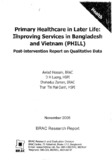Primary healthcare in later life: improving services in Bangladesh and Vietnam (PHILL): post-intervention report on qualitative data
Citation
Hossain, A., Luong, D. H., Zaman, S., & Oanh, T. T. M. (2005, November). Primary healthcare in later life: improving services in Bangladesh and Vietnam (PHILL): post-intervention report on qualitative data. Research Reports (2005): Health Studies, Vol - XXXVIII, 222–269.Abstract
When thinking of the development of primary healthcare, the position of older people within
households and communities should be taken into account. Relationships between primary
healthcare and infonnal support for older people, health education and the promotion of health
active life expectancy are of primary importance.
The Primary Healthcare in Later Life: Improving Service in Bangladesh and Vietnam
(PH ILL) project aimed at developing innovative and policy-relevant primary healthcare
delivery strategies for low-income countries targeted for older people. The project was
conducted with the aim to identify the effectiveness of low-cost, preventive and health
promotion interventions in improving the primary healthcare of people sixty years and older in
rural communities in Bangladesh and Vietnam. The three-year project (October 2002-
September 2005) was implemented as a collaborative project with four member partnerships
including the Karolinska Institutet (KI) in Sweden, the Bangladesh Rural Advancement
Committee (BRAC) in Bangladesh, the Health Strategy and Policy Institute (HSPI) in Vietnam
and Overseas Development Group (ODG)lUniversity of East Anglia (UEA) in the UK.
Both Bangladesh and Vietnam have placed a strong emphasis on the development of
primary healthcare services. Still, the scarcity of resources in the healthcare sector,
compounded by inadequate training, have often hindered the delivery of basic health services
to vulnerable groups. Although many changes have taken place within the society incluping the
healthcare sector, no study has investigated the impact of these changes on older people, and
no specific policies nor interventions have been introduced to improve healthcare for this
particular population group in these countries.
The study and its aims
The purpose of the study is to describe perceptive and cognitive aspects relating in health of
old people in Bangladesh and Vietnam, including aspects related to quality of life. The study
will also examine the healthcare related outcomes of the interventions provided.
The study sites in Bangladesh were located in four villages (Ashikati, Damokergaon,
Kumardugi and Mandari), in two unions (Ashikati and Shahmahmudpur), under Chandpur
Sadar thana in the Chandpur district. In these areas lived approximately 600 older persons. In
Vietnam, the study site was conducted in two communes in Chi Linh district, Hai Duong
province. The interventions were directed to older people, family caregivers and formal care
providers. All the caregivers came from elderly household. They were provided educational
interventions directed formal care providers and family caregivers and for older people
themselves. The interventions also had health check-ups and training activities for the older
people. Even self-help groups for older people were conducted.
Methods
In both countries the qualitative study was conducted both pre- and post-intervention by focus
group and individual interviews with older people themselves, main family caregivers and
healthcare providers. The data were obtained from the 60 years old and older people, their
caregivers and healthcare providers both before and after the intervention. The participants
were purposefully selected.

